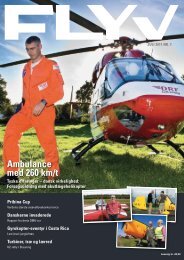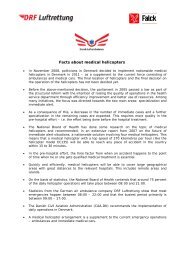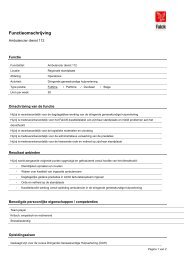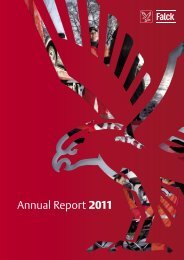Annual Report 2010 - Falck
Annual Report 2010 - Falck
Annual Report 2010 - Falck
Create successful ePaper yourself
Turn your PDF publications into a flip-book with our unique Google optimized e-Paper software.
66 <strong>Falck</strong> <strong>Annual</strong> <strong>Report</strong> <strong>2010</strong> | Group<br />
Notes to the Group financial statements<br />
Note<br />
2 Accounting estimates and judgments<br />
The calculation of the carrying amounts of certain assets and<br />
liabilities relies on judgments, estimates and assumptions<br />
about future events.<br />
The estimates and assumptions applied are based on historical<br />
experience and other factors that Management considers<br />
reasonable under the circumstances, but which are inherently<br />
uncertain and unpredictable. Such assumptions may be<br />
incomplete or inaccurate, and unexpected events or circumstances<br />
may occur. In addition, the Group is subject to risks<br />
and uncertainties that may cause actual outcomes to deviate<br />
from such estimates.<br />
Estimates material to the financial reporting are made in<br />
the calculation of, inter alia, depreciation, amortisation and<br />
impairment losses, pensions and similar liabilities, provisions,<br />
the determination of fair values, share-based compensation as<br />
well as contingent liabilities and assets.<br />
Amortisation and depreciation periods and scrap values<br />
In the determination of the carrying amount of intangible<br />
assets and property, plant and equipment, estimates are<br />
required of the estimated economic lives of the assets and of<br />
scrap values.<br />
Goodwill impairment test<br />
In the annual goodwill impairment test or in case of any<br />
indication of an impairment requirement, an assessment is<br />
made of how the parts of the Group (cash-generating units) to<br />
which the goodwill relates will be able to generate sufficient<br />
cash flows in future to support the value of goodwill and other<br />
net assets in the relevant part of the Group.<br />
As a result of the nature of the company’s business, expected<br />
cash flows must be estimated over a period of a number of<br />
years, which inherently produces some degree of uncertainty.<br />
This uncertainty is reflected in the discount rate applied.<br />
The impairment test of goodwill and the associated particularly<br />
sensitive factors and sensitivity analyses are described in<br />
note 15 to the consolidated financial statements.<br />
Provisions for acquisition of non-controlling interests<br />
In the determination of the fair value of issued put options<br />
under which the Group assumes an obligation to buy shares<br />
in subsidiaries held by non-controlling shareholders, Management<br />
makes certain estimates, including of the future<br />
financial performance of the subsidiaries, the probability that<br />
the option holders exercise their right to sell and the time<br />
of exercise. These factors are of material importance to the<br />
determination of the fair value, which is therefore subject to<br />
uncertainty.<br />
Purchase price allocation in business combinations<br />
In connection with the allocation of the purchase price in business<br />
combinations, a determination is made of the fair values<br />
of the assets and liabilities acquired. As this determination<br />
is based on expected future cash flows related to the assets<br />
and liabilities acquired, the realisation of such cash flows as anticipated<br />
is subject to an inherent uncertainty. In accordance<br />
with IFRS 3, the allocation of the purchase price in business<br />
combinations may be adjusted for up to 12 months from the<br />
date of acquisition.
















